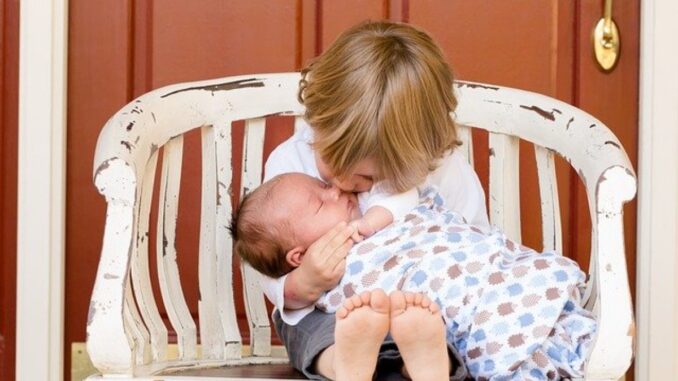
Birthing cottages at The Farm, a well-known midwifery center in Summertown, Tennessee.
Alabama has a rich tradition of midwifery, but it is one that has virtually been erased from living memory. As in most places in the United States, until the mid-1800s it was midwives who were responsible for delivering children. Birth was something that happened in the home, among women. To this day, midwives still refer to their work as “catching babies”—reflecting a belief that birth doesn’t require medical intervention under normal circumstances, just a pair of hands to safely collect the child.
But as medicine became professionalized, its leading practitioners took a very different view. In 1915, the influential obstetrician Joseph DeLee declared that midwifery was a “relic of barbarism.” He also called on physicians to save women from the “pathologic” process of labor using sedatives, forceps and episiotomies—the surgical cutting of the perineum. By the early 1930s, nearly two-thirds of births in the U.S. happened in a hospital.
There was one place where midwives remained crucial: the South. During Jim Crow, black families could not access white hospitals and white doctors often refused to treat them, so it fell to black “granny midwives” to deliver children. In Alabama, Margaret Charles Smith caught her first baby at the age of 5 and, in her own telling, went on to deliver 3,500 children without losing a single mother. She once described saving an extremely premature baby by making an incubator out of a cardboard box and hot water bottles. Onnie Lee Logan started practicing in 1931, delivering nearly every child born in one black Mobile suburb. “I do all my work keepin em from having lacerations and havin to have stitches,” she recounted in her book, explaining how she used hot towels to stretch the skin and how she knew exactly when the mother should start pushing so the baby was positioned correctly.
Midwives Stacie, Rachel Hart and Beth.
The 1964 Civil Rights Act, as well as the introduction of Medicare and Medicaid, eventually led to the integration of medical services. By the 1970s, 99 percent of American births took place in hospitals and states were passing laws preventing midwives from practicing, ostensibly for health and safety reasons. Alabama ended the legal practice of lay midwifery in 1976. A tiny number of home birthers persisted, mostly white, middle-class women seeking an alternative to the hospital. It was technically a misdemeanor for midwives to assist them, but the likelihood of being prosecuted seemed slim.
One woman who defied the ban was Karen Brock. She’d delivered hundreds of babies since the 1980s, following the example of her midwife grandmother. In 2002, Brock was attending a birth that was complicated by a ruptured uterus and cord prolapse, which occurs when the umbilical cord drops through the open cervix into the vagina. She rushed the mother to the hospital, where the baby died. According to Brock, the doctor said her actions saved the mother’s life, but she was charged with the misdemeanor of practicing nurse midwifery without a license and pleaded guilty.
Brock, 61, is petite with straight silver hair and an abiding affection for Chaco sandals. She told me that at the time of her arrest, she didn’t want to abandon the 27 Alabama families still in her care. So she decided to move her practice to Tennessee, where she could operate as a certified professional midwife. (Certified midwives do not have to be nurses, but undergo training and apprenticeship programs.) For a couple of months, she delivered babies in a trailer in a midwife’s backyard. Then she rented a house in a small town right on the Alabama border. After about five years, she received a cease-and-desist order from the state of Tennessee for running an unauthorized birth center. (The state defines a birth center as any building “exclusively or primarily” dedicated to birth.)
The day she received the order, Brock happened to be attending a birth for a family from Huntsville, Alabama. When Brock told them about the cease-and-desist, they decided to help. “My husband and I really felt like the Lord called us to do it,” said a woman I’ll call Debbie, who asked to remain anonymous.
After months of searching, Debbie and her husband bought a three-bedroom house in southern Tennessee and enlisted friends and relatives to help convert it into a two bedroom, two bath.
They installed a capacious hot tub and an extra water heater. It is now one of about half a dozen birthing cottages scattered around the towns of St. Joseph, Elkton, Pulaski and Lawrenceburg. There is also a renowned midwifery center nearby in Summertown called The Farm, which has cottages that expecting families can rent. The Farm was originally founded as a commune in the 1970s by hippies who caravanned across the country from San Francisco in school buses. Many of the women in the caravan were pregnant and learned how to deliver each other’s babies, which inspired them to become midwives.

Karen Brock treats patients at her clinic.



Karen Brock treats patients at her clinic.
Alabama’s border birth community is a tightknit sisterhood. It includes engineers, meteorologists, nurses, real estate agents and stay-at-home moms of varying political persuasions. They drop terms like “proven pelvis” and “colustrum” into casual conversation and share information via word of mouth. The cottages don’t openly advertise their services, for fear of being identified as unlicensed birth centers.
In theory, any Airbnb or vacation property could be used as a birthing cottage, but there are benefits to using one within the network. The owners are supportive and flexible about booking. After a birth, Debbie and her family clean the house themselves. (“It’s hard to find someone and say, ‘There may be blood, you may need to wear gloves, and the tub needs to be disinfected,’” she explained.) The cottages, which cost anywhere from $250 to $1,500 a week, tend to be filled with the quaint, fusty furniture that inhabits secondary properties everywhere. One is affectionately known as the “barbershop house” because the owner also cuts hair in the garage. When Marie Douthit’s husband dropped off supplies there in preparation for his wife’s labor, he got a quick trim.
Douthit decided to jump the border after her first pregnancy resulted in a C-section that left her deeply distressed. A data-oriented engineer, she ran the numbers and concluded that a home birth with a midwife was less risky than another C-section in a hospital. She went into active labor for her second baby on January 18, 2017. On the way to the barbershop house, Douthit and her husband stopped to use the bathroom and get Douthit a Hardee’s milkshake. A convenience store clerk asked if she needed an ambulance, and Douthit, who was terrified of being taken to the hospital, rushed back to the car. When they reached the cottage, the midwives didn’t even have time to fill the tub all the way to the top before she felt the urge to push. Her baby was born an hour later.

Marie Douthit and her children at home.
Brianna Barker gave birth using the network around the same time. She’d had her first child at 20; the baby was preterm and breach. It was months after her C-section before she could even walk standing up straight; she still has recurring nightmares about being trapped in a dark hospital. She used birthing cottages for her third and fourth pregnancies. For one of them, her doula taught Barker and her husband how to do a car birth just in case the baby came during the two-and-a-half-hour drive.
One reason Barker opted to use a midwife was that many doctors and hospitals won’t allow women to give birth vaginally after a C-section, due to a widespread misconception that a vaginal birth after cesarean, or VBAC, is unsafe. In fact, VBACs are associated with fewer complications than elective repeat C-sections, according to the Mayo Clinic. The American College of Obstetricians and Gynecologists (ACOG) endorses their use for low-risk moms, although it doesn’t recommend VBACs outside a hospital environment and generally supports hospitals and accredited birth centers as a safer option than home birth.
There have been no large-scale randomized clinical trials of planned home birth that the ACOG considers adequate. Existing research suggests that in the U.S., they are associated with fewer interventions but also with higher rates of infant death. In countries like the Netherlands and Canada, however, where home birth is well established, it’s considered safe. A study that included researchers from the University of British Columbia; the Child and Family Research Institute in Vancouver; King’s College, London; and the University of Alberta, Edmonton compared planned home birth with planned hospital birth. The authors found that home birth was associated with “very low and comparable rates of perinatal death,” as well as fewer surgeries and complications for moms.
All 14 Alabama women I spoke to said their decision to jump the border was connected to their desire to avoid unnecessary medical procedures. Most of them described harrowing hospital experiences—being derided for writing a birth plan, feeling pressured into C-sections, epidurals or Pitocin, a synthetic hormone that induces contractions.
Alabama is one of nine states where more than 34 percent of deliveries are cesareans. The ideal, according to the World Health Organization, is 10 to 15 percent. While cesareans may be essential in complicated births, they can come with higher risks of (sometimes life-threatening) complications and infection. “You have to look at the outcomes from hospital births, and they are not that good,” said Dr. Jesanna Cooper, an obstetrician who works with nurse-midwives in her Birmingham practice. “If it’s risky to have a hospital birth, it’s pretty hard to say a home birth is too risky.”

